Chile Backcountry Ski Adventure Recap

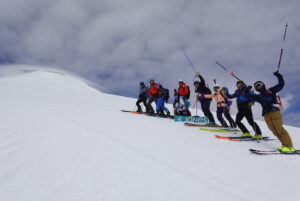
Words by Alpenglow Guide Sam Kieckhefer
“For anyone who has spent time in the US’s Pacific Northwest, you’re familiar with the southern Cascades volcanoes. Maybe you’ve driven along I-5 and stared up at Mt Shasta towering above, or enjoyed a rooftop cocktail in Portland, OR, peering east at Mt Hood. Wherever you’ve seen them, they’re simply stunning. Across the equator, about 6500 miles south, sits an equally as magical series of volcanos in Chile’s Lake District, with small cities and little towns dotting the region, all along, ironically, the Ruta 5 Sur highway. First, rewind to the start.
The Start
 Like every trip, it always starts and ends at home. Packing for an international ski trip in September is no easy feat; Remembering where each piece of gear is, ensuring everything is packed, all while managing to not stub a toe while packing ski gear wearing flip flops. It’s always a bit crazy, but an overnight flight means waking up in Santiago Chile, and the temperatures immediately remind you it’s now winter. On my first adventure south to Chile, as the hustle and bustle of its capital city existed around, all I could feel was calm as the realization of a September ski trip was no longer a dream and now a reality. After a puddle jumper to Temuco, it was on, and Gaspar, Diego and I would be skiing before too long. After a couple days of “trip prep”, our clients arrived. Their enthusiasm was equal to my own, but I’d had a few days to get comfortable. After driving to Malalcahuello, we settled into the Endemiko lodge. Owned, operated and built by a mountain guide, this was the perfect home base for our first few days of skiing. Dinner at Endemiko gave us plenty of fuel for our first day of ski mountaineering, and we agreed on an 8am departure for Volcán Lonquimay.
Like every trip, it always starts and ends at home. Packing for an international ski trip in September is no easy feat; Remembering where each piece of gear is, ensuring everything is packed, all while managing to not stub a toe while packing ski gear wearing flip flops. It’s always a bit crazy, but an overnight flight means waking up in Santiago Chile, and the temperatures immediately remind you it’s now winter. On my first adventure south to Chile, as the hustle and bustle of its capital city existed around, all I could feel was calm as the realization of a September ski trip was no longer a dream and now a reality. After a puddle jumper to Temuco, it was on, and Gaspar, Diego and I would be skiing before too long. After a couple days of “trip prep”, our clients arrived. Their enthusiasm was equal to my own, but I’d had a few days to get comfortable. After driving to Malalcahuello, we settled into the Endemiko lodge. Owned, operated and built by a mountain guide, this was the perfect home base for our first few days of skiing. Dinner at Endemiko gave us plenty of fuel for our first day of ski mountaineering, and we agreed on an 8am departure for Volcán Lonquimay.
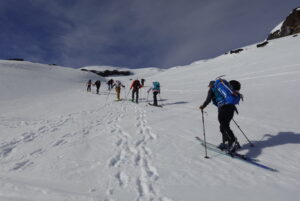 At the base of Lonquimay is the Corralco ski area, but we opted to skin from the lot. While we started with clear skies, clouds moved in around 11am, but we pushed through the cloud ceiling and a few hours later we were looking up at the summit only a few hundred feet away and just below us was a blanket of clouds and no land in sight. About 500 feet shy of the summit, we transitioned to boots and crampons and climbed our way to the top! The excitement was palpable, and there’s no better feeling than having success on the first objective of the trip. A long ski down provided mixed conditions, first some firm turns but as we descended each turn became softer and softer until perfect corn was found. A quick celebratory dinner at Los Randonnes would follow, but we needed to rest in preparation for our biggest objective of the trip the following day.
At the base of Lonquimay is the Corralco ski area, but we opted to skin from the lot. While we started with clear skies, clouds moved in around 11am, but we pushed through the cloud ceiling and a few hours later we were looking up at the summit only a few hundred feet away and just below us was a blanket of clouds and no land in sight. About 500 feet shy of the summit, we transitioned to boots and crampons and climbed our way to the top! The excitement was palpable, and there’s no better feeling than having success on the first objective of the trip. A long ski down provided mixed conditions, first some firm turns but as we descended each turn became softer and softer until perfect corn was found. A quick celebratory dinner at Los Randonnes would follow, but we needed to rest in preparation for our biggest objective of the trip the following day.
At 4:45 our alarms rang out, and the realization that sleep was over was met by anxious energy. We forced down what our stomachs could endure, and hit the bus for a bit of a drive to the base of Llaima. Road conditions prevented us from taking the short cut, but the two and a half hour drive seemed to fly by as we caught a few extra minutes of shut eye. After arriving at the base of Llaima, we quickly threw on our boots and skins, and were moving before we knew it. The cold morning slowly gave way, as the sun peaked over the hills and our internal engines revved. The day was stunningly clear, and conditions were excellent. About 3,000’ of skinning later, we encountered steeper slopes and made the decision to transition to boots and crampons. As we climbed, ski conditions deteriorated and we encountered ice. About 100’ later, it was clear these conditions would not let up, and we chose to leave our skis and the packs of our clients hanging on the slope from an anchor built in the snow. Steep and icy cramponing to the summit kept everyone’s attention at the task on hand, and moments later we were crossing snow bridges over thermal vents from the top of the volcano. Time on the summit was brief, and we still had difficult terrain to cover. After returning to our skis, we carried them about 200’ lower until skiable snow was found, clicked in and were off, descending thousands of feet to the valley below. Again, firm snow became soft and nearly perfect corn, and before we knew it we were back at the van.
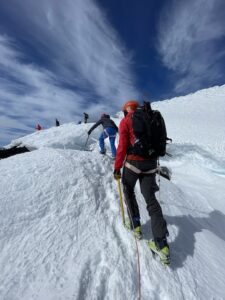
In Search of Perfect Corn
Our time in Malalcahuello had come to and end, but more skiing out of Pucon and Puerto Varas was waiting for us. The following day, we began our trek south and arrived in Pucon in the early afternoon. The day of travel provided much needed rest for our legs. After exploring the town, we made a plan for our next ski objective: Volcan Villarica. The next morning arrived before we knew it, and the weather forecast was looking questionable. That being said, you never know until you go! We arrived at the base of Villarica and the anticipated clouds were nowhere to be seen. We geared up and just like the last few, we began skinning. Hours later, and thousands of vertical feet, we were staring up at the summit crater, and across at a wave of dark clouds. Winds had been increasing as we climbed, and it was now a bit chilly and quite windy. We made the difficult decision to descend as the idea was getting caught at the summit with strong winds and no visibility was not an option. While this was a tough decision, it was justified by perfect corn, so good we stopped 2,000’ into our descent and skinned back up for more. The clouds had dissapted, but perfect corn was our new focus, and Villarica delivered. The playful terrain and untouched lines forced hoots and hollers as we descended nearly 6,000’ in perfect conditions.
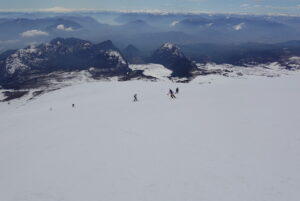 With 2 summits and 3 great days in the bag our trip was already a success, but Volcan Osorno remained. Unfortunately, an Atmospheric River was moving in, pointing straight at us. After arriving in Puerto Varas, precipitation started, and there was no end in sight. Our last objective was looking unlikely, but an extra day added allowed us to squeeze in a short tour at the base of Osorno on departure day. It was a nice bonus and nearly 100cm of snow had fallen, but like any good atmospheric river we’re used to in the states it came with gale force winds. Snow conditions were not as the stats suggested, but the views were worth the squeeze and everyone departed with a grin from ear to ear. Our adventures south had delivered, and no one in the group was ready to leave. The experience skiing in Chile’s lakes district has so many parallels to the US’ southern cascade range, but the culture and people of the area make the trip a memorable international experience, one best enjoyed through snow. I can only hope this is my first of many visits to such a wonderful country.”
With 2 summits and 3 great days in the bag our trip was already a success, but Volcan Osorno remained. Unfortunately, an Atmospheric River was moving in, pointing straight at us. After arriving in Puerto Varas, precipitation started, and there was no end in sight. Our last objective was looking unlikely, but an extra day added allowed us to squeeze in a short tour at the base of Osorno on departure day. It was a nice bonus and nearly 100cm of snow had fallen, but like any good atmospheric river we’re used to in the states it came with gale force winds. Snow conditions were not as the stats suggested, but the views were worth the squeeze and everyone departed with a grin from ear to ear. Our adventures south had delivered, and no one in the group was ready to leave. The experience skiing in Chile’s lakes district has so many parallels to the US’ southern cascade range, but the culture and people of the area make the trip a memorable international experience, one best enjoyed through snow. I can only hope this is my first of many visits to such a wonderful country.”
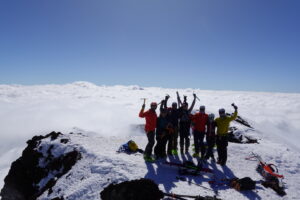
Stoked on getting out Skiing with us? Reach out the office to see what adventures we can get up to together! Adventures like:
Ecuador Ring of Fire
 Alpenglow is thrilled to be offering the Ring of Fire Ski Expedition. Our high altitude guides are also big mountain ski mountaineers. The combination of their expertise and high-end logistics that have been a priority of Alpenglow’s for over a decade, has us uniquely positioned as the first guide service to offer international, high altitude ski expeditions. We created this program as a perfect segue for backcountry skiers looking to gain the skills that will enable them to ski higher and more technical mountains. This program is for the backcountry skier who wants to become a ski mountaineer, and the ski mountaineer looking to progress to high altitude peaks. Climb and ski Cayambe, Cotopaxi, and Chimborazo.
Alpenglow is thrilled to be offering the Ring of Fire Ski Expedition. Our high altitude guides are also big mountain ski mountaineers. The combination of their expertise and high-end logistics that have been a priority of Alpenglow’s for over a decade, has us uniquely positioned as the first guide service to offer international, high altitude ski expeditions. We created this program as a perfect segue for backcountry skiers looking to gain the skills that will enable them to ski higher and more technical mountains. This program is for the backcountry skier who wants to become a ski mountaineer, and the ski mountaineer looking to progress to high altitude peaks. Climb and ski Cayambe, Cotopaxi, and Chimborazo.